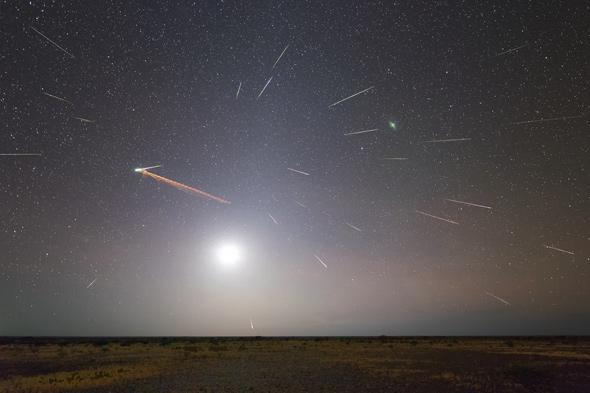Experts are predicting we may be in for quite a show: a brand spanking new meteor shower that will peak on the evening of Friday, May 23, 2014! Folks in the United States and Canada have the most favored viewing locations for this event (but that doesn’t mean you should forget about it if you’re elsewhere). Predicted rates for this new shower are quite high, about 100–400 meteors per hour, far higher than normal showers. And they’ll appear to be coming from an area of the sky near the north pole, so they should be visible raining down all over the sky!
Mind you, this is not a rock-solid (har har) guarantee. Meteor showers are mercurial, and very difficult to predict. We may get a good shower, or we may not get much at all. However, don’t let that discourage you: You should go out and try to see it if you can. I’ll explain all this here, and then give you instructions on how to view it.
But first, just a note: We are in no danger from this event. The parent comet misses us by a wide margin in human terms, and we expect any debris from it that supplies the shower will burn up high in our atmosphere. So just enjoy the show!
Night of the Comet
Meteor showers result when the Earth passes through a stream of debris left from a comet. Comets are odd beasts—mostly rock and ice, if their orbit around the Sun takes them close enough to the star, they heat up and the ice sublimates, turning directly into a gas. This means grains, pebbles, and rocks, can dislodge and move away from the solid part of the comet (called the nucleus), creating debris trails. Think of them like the bits of gravel that can fly off a truck you’re following on the highway.
As the Earth orbits the Sun, it sometimes crosses these trails. When that happens we plow into this interplanetary junk, and it burns up in our atmosphere, creating meteors. They appear to come from a single point in the sky called the radiant, because the meteors appear to radiate outward from it (see the photo at the top of this post). This is due to perspective, and is similar to how lights on the walls and ceiling of a tunnel all seem to come from a point directly ahead of you as you drive through the tunnel, and they fan out as you pass them. The radiant for this shower is in the relatively obscure constellation Camelopardalis, the giraffe, very near the north pole of the sky (see Item No. 1 below for more info).
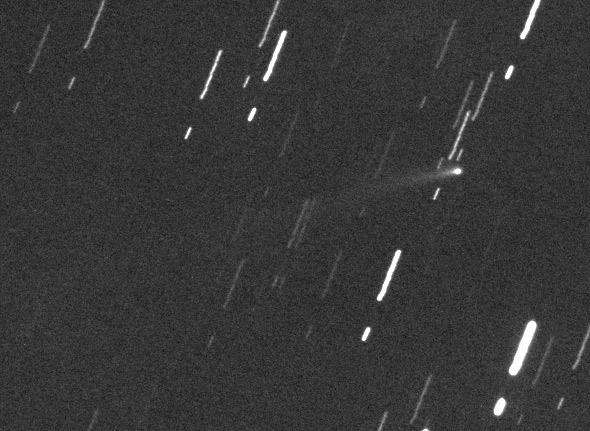
Photo by Gianluca Masi, The Virtual Telescope Project
The parent comet for this new shower is called 209P/LINEAR, and it was discovered in 2004. It’s pretty small, probably only about 600 meters (2,000 feet) or so in diameter (many comets are dozens of kilometers across). It takes five years to orbit the Sun on a path that’s tilted to the Earth’s, but passes pretty close to it. The comet itself will zip past us on May 29, 2014, getting rather close: about 8.3 million kilometers (about 5 million miles). That’s a clean miss, but close enough that we’ll pass through several of its older debris trails at almost the same time.
That will occur on May 24, at about 07:20 UTC (03:20 a.m. EDT on the night of May 23-24). However, this being a new shower—the Earth hasn’t gotten this close to the comet in recent history, and this proximity is what ramps up the amount of junk that hits us—it’s not easy to predict just how many meteors we might see or when they’ll come in. It might be earlier, or later. I suggest getting out as soon as it’s dark, and checking the sky every half hour or so.
Interestingly, some astronomers studying the comet have found that it appears to have a low production rate of dust, which means it doesn’t shed as much material as other comets. However, they also found that the sizes of the particles are larger, which means they’ll be brighter as they burn up in our air. So we may really be in for quite the show!
So, assuming it happens, how do you watch this meteor shower?
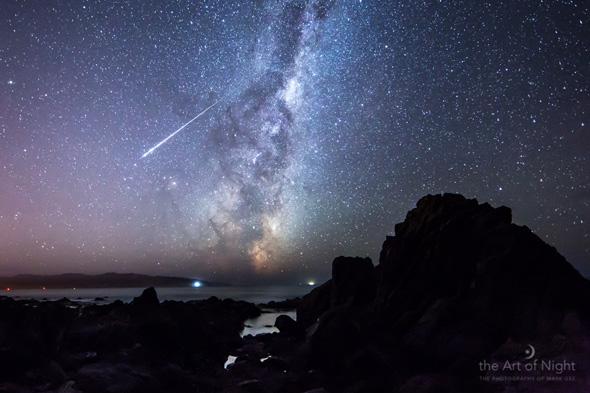
Photo by Mark Gee, used by permission
How to Watch the Meteor Shower
Bottom line: On Friday evening, go outside. Look up. Wait. Oooohh and ahhhh when you see one.
Got it? OK, now for some specifics. Just to make it easy, I’ll enumerate them.
0) Watch (and Listen!) Online
I give this the No. 0 because it’s not ideal, but it may be your only option if it’s cloudy or you’re stuck inside. As I write this there aren’t many places advertising live streaming of the shower online, but a good one is the Virtual Telescope Project. I’ll add more that I like here as I find them.
Also, did you know that meteors produce trails of ions that can create radio echoes, and these can be detected and converted into sound? That means you can listen to the meteor shower too! The converted sound is eerie and lovely, so you should keep a channel open to listen for them. It’ll add an appropriately spooky element to the whole thing.
1) Wide Open and Dark Skies
The radiant point for this new shower is in the constellation of Camelopardalis (the giraffe), so this new shower is called the Camelopardalids, which is just as hard to spell as it is to pronounce. The constellation is very near the north pole of the sky, near Polaris. If you face north, just after sunset it’ll be just to the left of Polaris, and will swing down under it over the next few hours.
But you don’t have to face that way to see the show. In fact, the meteors will be streaking across all parts of the sky, so what you really want is a wide, open space where you can lie back and see as much cosmic real estate as possible. The more sky you can see, the more meteors you can see.
On top of open skies, you want to be where it’s dark. That’s not critical, but you’ll see more from a farm in Kansas than on Lexington Avenue in NYC. If you can get away from city lights, that’s better. I’ll be in my backyard, where a fence and trees block my neighbor’s lights, yet I still have a pretty good view of the sky.

Diagram by AU and Sky & Telescope magazine (Roger Sinnott & Rick Fienberg)
2) Time
It takes a few minutes for your eyes to adjust to the dark (your pupils dilate, letting in more light, and your eye produces a light-sensitive protein called rhodopsin), so give yourself a few minutes to get dark-adapted. White light will snap your pupils tighter and bleach the rhodopsin, so try to avoid going back inside or using a bright flashlight once you’re settled in.
3) Get Comfy
Even if the shower peaks at 400 per hour (I hope I hope I hope) you’ll want to be outside a while to watch. Get comfortable. I usually lie back in a lawn chair, or even throw an old blanket on the grass. Mind you, it can get chilly at night even in the middle of spring, so dress appropriately, and maybe have a blanket at hand.
4) Pay Attention
I’ve said it before and I’ll say again: Keep looking up! Meteors travel very rapidly, over a dozen kilometers per second (some much faster), and most zip across the sky in less than a second. It’s easy to get distracted lying out in the dark, especially if you’re with other people, so don’t forget the main reason you’re out there.
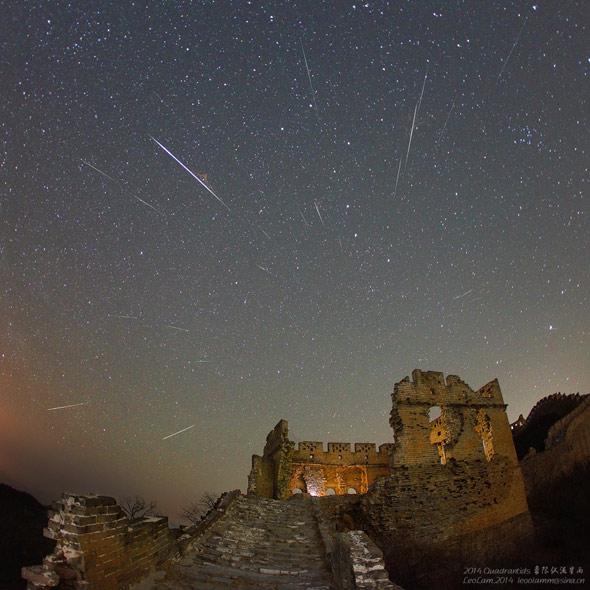
Photo by Leo Lam, used by permission
5) Telescope? Nope. Camera? Maybe.
Speaking of which … TV shows and movies always depict people looking through telescopes during meteor showers, but that’s a terrible idea. Meteors zip across the whole sky, and you’ll miss them if you’re hunched over a telescope eyepiece! You’re best instrument is your eyes. Just look up. Having said that, I do bring binoculars with me, so I can scan the sky every now and again. But bear in mind you’ll inevitably miss part of the show if you do.
However, if you have a decent camera, you can get some fun pictures of the event. I found lots of tutorials online on how to get good shots. But again, like with a ‘scope, if you spend your time outside fussing over the equipment you’ll miss actually experiencing the shower! I love a good photo, but don’t sacrifice the night fooling around trying to get one when the show is going on over your head.
6) A Star Chart
You’ll be outside looking up, and the stars will be spread across the heavens above you. Why not learn your way around? Start at Polaris, find the Big Dipper (to the upper left, more or less), and move on from there. Face south and west and you’ll see Mars, Saturn, and the Milky Way (later at night). The waning crescent (30 percent lit) Moon won’t rise until about 2:30 a.m., so it won’t ruin the sky at all. Once you’re more familiar with the sky, investigating it is even easier and more fun. You can find lots of printable ones online, and planetarium software can work, too (I like Sky Safari).
7) Rest
If you plan on staying out all night, make sure you get a good night’s sleep beforehand. Watching the sky at night is very relaxing, and I know a lot of folks who have fallen asleep and missed meteor showers because of it.
8) Friends and Family
Meteor showers are fun, exciting and really pretty. Why not share them? Gather a few folks and enjoy the experience together.
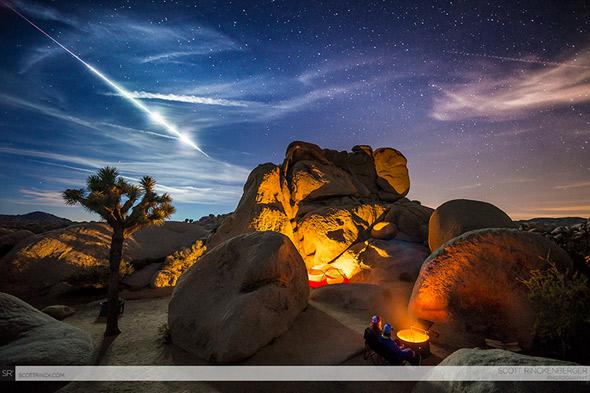
Photo by Scott Rinckenberger, used by permission
9) Mobile Device
I dithered on including this, but Twitter will be very useful for up-to-the-second info on the shower. I plan on letting folks know what’s what, so it’s not a bad idea to stay connected. Make sure you turn the brightness down though (see No. 3). And that way you can listen for the meteors too, as I mentioned above.
10) A Sense of Joy and Wonder
Think about this: When you see a shooting star streak across the sky what you’ve just witnessed is a piece of a small comet, perhaps the size of a grain of sand, ejected decades or centuries ago, that’s been orbiting the Sun on its own freely ever since. But a giant blue green planet loomed large, directly in its way. As it plummeted through our atmosphere at many times the speed of a rifle bullet, the extreme pressure it underwent as it compressed the air in front of it heated it up, frying it while it was still 100 kilometers above the Earth’s surface. It left a glowing trail of ionized plasma, vaporized space dust heated to incandescence by the violent passage. After billions of years orbiting the Sun, a piece of stardust ends its existence in less than a second, emitting light that travels the rest of the distance to the Earth in a few milliseconds, entering your eye, and sparking the multiple pathways of delight and awe in your brain.
You see? Meteor showers are lovely, fun, and delightful … but when you know what you’re actually seeing, you can stand on the threshold of awe that leads to a far, far bigger world.
Corrrection, May 20, 2014: I originally wrote that meteors travel “many dozens of kilometers per second,” which in general is true. However, due to the orbit of this comet, it’s passing us relatively slowly, and the velocity of the Camelopardalids is expected to be slower than normal.
